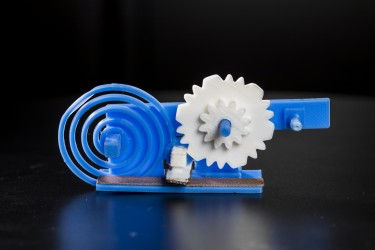| WiFi Sensors With No Electronics |
| Written by Harry Fairhead | |||
| Tuesday, 19 December 2017 | |||
|
This is a clever idea that solves the real problem of the IoT - creating sensors that can work without being hardwired to anything. It is difficult to know how practical this approach is but it deserves understanding because it not only eliminates the need for a battery but for any electronics at all. If you have tried to design any IoT sensor you will know that a big problem is getting something that can run off batteries for a long time. Communicating over WiFi, or similar technologies, is power hungry and this makes the problem of running a processor and other sensor electronics even more challenging. Conventional solutions are to attempt to minimize the power consumption by switching the electronics into sleep mode and only waking up to transmit data every so often. This is a tough problem. A more advanced idea is to try to harvest energy from the WiFi signal itself or less of a challenge to use solar cells, which is only less of challenge if the sensor is outside. Now a team from the University of Washington has invented some sensors that not only need no batteries, they don't actually use any electronics. The idea is based on passive manipulation of the radio or magnetic fields around the sensor. When a WiFi device transmits the signal bounces off the objects it encounters. This is called backscatter and it can be detected by a receiver positioned at a distance. If you can find some way to change the reflectivity of a device then you can send data in the backscatter. This is very like the old trick of using a mirror to reflect the sun onto a target and by moving the mirror the data can be encoded in the flashes that are seen. In this case the mirror is an antenna tuned to 2.4Ghz, the frequency that is the most common form of WiFi. The aerial takes the classical form of a dipole and if the two arms of the dipole are connected it reflects the radio waves. If the two arms are disconnected then it reflects far less energy. The trick is to engineer a switch that can be actuated by a gear wheel with zeros and ones coded as non-teeth and teeth. As the gear wheel rotates it pushes an actuator down onto the dipole to connect the two halves.
Once you have this basic mechanism you can start to invent ways of coding the data onto the "flashing". At the moment the sensors are for cases where what is being sensed can drive a gear wheel - so we have an air speed and water flow indicator. We also have positional controls and simple switches. More difficult is to see how to drive the wheel with a temperature or humidity change say. What is needed is something that changes how fast something rotates in response to the quantity being measure.
Take a look at the video to see the sorts of things that have been successful:
The paper, published at SIGGRAPH, also describes a way of using magnets and the magnetometer that you find in most smartphones to do the same job, but it is clearly the WiFi backscatter method that can perform sensing over large areas without the need for power. The test setup achieved good results 17m from the transmitter. It isn't difficult to see that the gear wheels could also include an id code that allows more than one sensor to work with the same transmitter, but separating the backscatter would probably need a directional aerial. Some basic tests using different frequencies of data encoding seems to work quite well, however.
More Information3D Printing Wireless Connected Objects Vikram Iyer, Justin Cham and Shyam Gollakota Related ArticlesPower Over WiFi - Really Wireless XANDEM RF Tomography A New Approach To Home Security Your WiFi knows where you are! Turn Any Surface Into A Touch Screen With Kinect
To be informed about new articles on I Programmer, sign up for our weekly newsletter, subscribe to the RSS feed and follow us on Twitter, Facebook or Linkedin.
Comments
or email your comment to: comments@i-programmer.info
|
|||
| Last Updated ( Tuesday, 19 December 2017 ) |
 The 3-D printed gears (in white) and spring (blue spiral) toggle a switch (white box with grey surface) made of conductive plastic.
The 3-D printed gears (in white) and spring (blue spiral) toggle a switch (white box with grey surface) made of conductive plastic.

